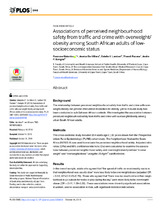| dc.contributor.author | Malambo, Pasmore | |
| dc.contributor.author | De Villiers, Anniza | |
| dc.contributor.author | Lambert, Estelle V. | |
| dc.contributor.author | Puoane, Thandi | |
| dc.contributor.author | Kengne, Andre P. | |
| dc.date.accessioned | 2018-11-19T09:07:07Z | |
| dc.date.available | 2018-11-19T09:07:07Z | |
| dc.date.issued | 2018 | |
| dc.identifier.citation | Malambo, P. et al. (2018). Associations of perceived neighbourhood safety from traffic and crime with overweight/obesity among South African adults of low-socioeconomic status. PLoS ONE, 13(10): e0206408. | en_US |
| dc.identifier.issn | 1932-6203 | |
| dc.identifier.uri | https://doi.org/10.1371/ journal.pone.0206408 | |
| dc.identifier.uri | http://hdl.handle.net/10566/4209 | |
| dc.description.abstract | BACKGROUND
The relationship between perceived neighbourhood safety from traffic and crime with overweight/
obesity can provide intervention modalities for obesity, yet no relevant study has
been conducted in sub-Saharan African contexts. We investigated the association between
perceived neighbourhood safety from traffic and crime with overweight/obesity among
urban South African adults.
METHODS
This cross-sectional study included 354 adults aged ~35 years drawn from the Prospective
Urban Rural Epidemiology (PURE) cohort study. The Neighborhood Walkability Scale-
Africa (NEWS-A) was used to evaluate the perceived neighbourhood safety. Adjusted odds
ratios (ORs) and 95% confidence intervals (CIs) were calculated to examine the associations
between perceived neighborhood safety and overweight/obesity defined “normal
weight” and “overweight/obese” using the 25 Kg/m2 cutoff criterion.
RESULTS
In the overall sample, adults who agreed that “the speed of traffic on most nearby roads in
their neighborhood was usually slow” were less likely to be overweight/obese (adjusted OR
= 0.42; 95%CI 0.23–0.76). Those who agreed that “there was too much crime in their neighborhood
to go outside for walks or play during the day” were more likely to be overweight/
obese (OR = 2.41; 1.09–5.29). These associations were driven by significant associations
in women, and no association in men, with significant statistical interactions.
CONCLUSION
Perceived neighborhood safety from traffic and crime was associated with overweight/obesity
among South African adults. Our findings provide preliminary evidence on the need to
secure safer environments for walkability. Future work should also consider perceptions of
the neighbourhood related to food choice. | en_US |
| dc.language.iso | en | en_US |
| dc.publisher | Public Library of Science | en_US |
| dc.rights | © 2018 Malambo et al. This is an open
access article distributed under the terms of the
Creative Commons Attribution License, which
permits unrestricted use, distribution, and
reproduction in any medium, provided the original
author and source are credited. | |
| dc.subject | Perceived neighbourhood safety | en_US |
| dc.subject | Traffic | en_US |
| dc.subject | Crime | en_US |
| dc.subject | Overweight/ obesity | en_US |
| dc.subject | sub-Saharan African context | en_US |
| dc.title | Associations of perceived neighbourhood safety from traffic and crime with overweight/ obesity among South African adults of low socioeconomic status | en_US |
| dc.type | Article | en_US |
| dc.privacy.showsubmitter | FALSE | |
| dc.status.ispeerreviewed | TRUE | |
| dc.description.accreditation | ISI | |

